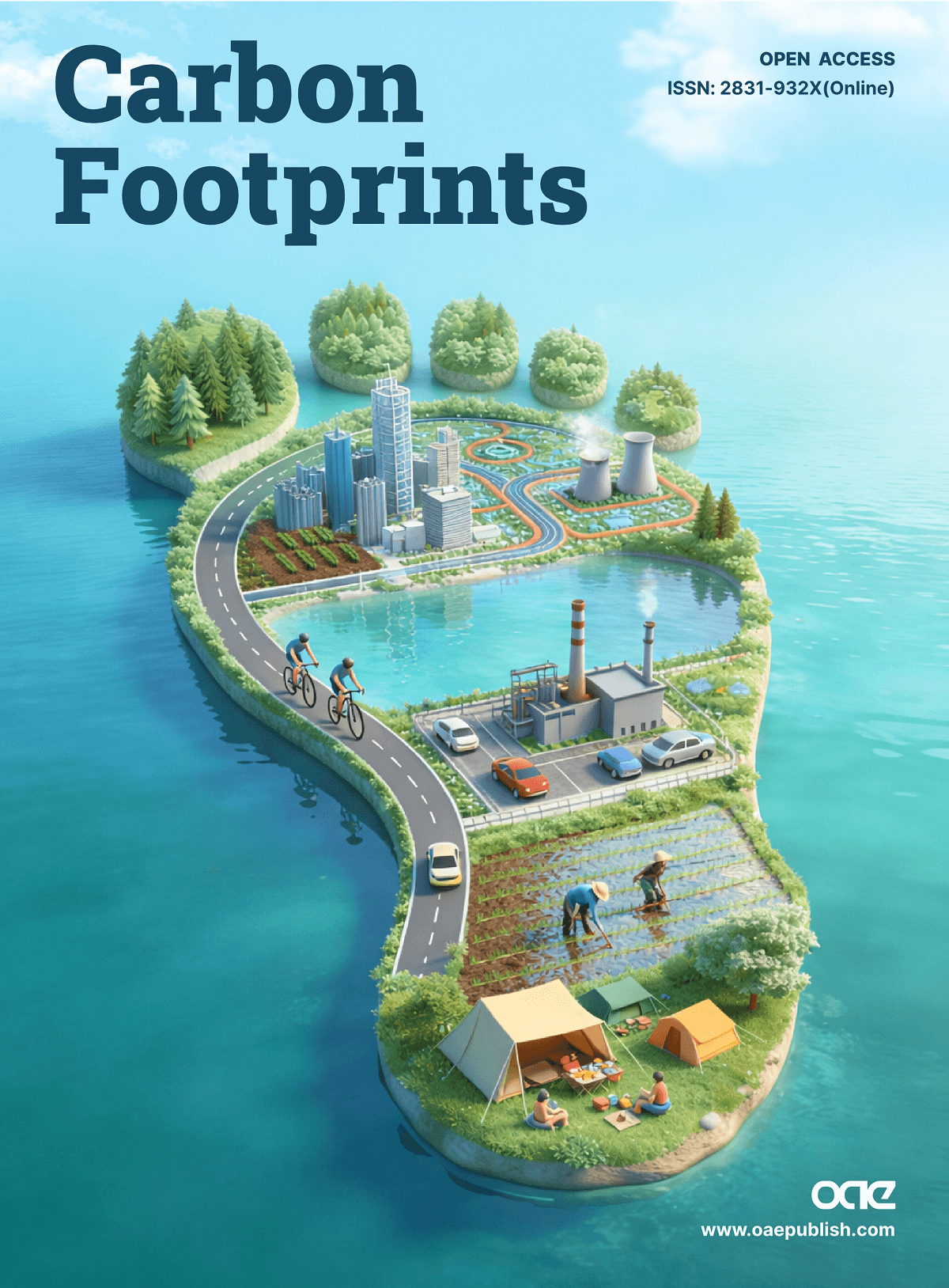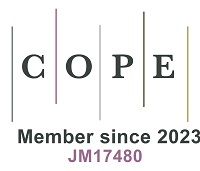REFERENCES
1. Ali Y, Pretaroli R, Socci C, Severini F. Carbon and water footprint accounts of Italy: a multi-region input-output approach. Renew Sust Energ Rev 2018;81:1813-24.
2. Weber CL, Matthews HS. Quantifying the global and distributional aspects of American household carbon footprint. Ecol Econ 2008;66:379-91.
3. Wackernagel M, Rees W E. Our ecological footprint: reducing human impact on the earth. New Catalyst Books; 1996.
4. Matthews HS, Hendrickson CT, Weber CL. The importance of carbon footprint estimation boundaries. Environ Sci Technol 2008;42:5839-42.
6. European Commission. Harmonised rules for the calculation of the carbon footprint of electric vehicle batteries (CFB-EV). Available from: https://eplca.jrc.ec.europa.eu/GRB-CBF_CarbonFootprintRules-EV.pdf [Last accessed on 15 Dec 2023].
7. Hertwich EG, Peters GP. Carbon footprint of nations: a global, trade-linked analysis. Environ Sci Technol 2009;43:6414-20.
8. Baldo GL, Marino M, Montani M, Ryding S. The carbon footprint measurement toolkit for the EU Ecolabel. Int J Life Cycle Assess 2009;14:591-6.
9. Wiedmann T, Minx J. A definition of ‘carbon footprint’. Available from: https://www.researchgate.net/publication/247152314_A_Definition_of_Carbon_Footprint [Last accessed on 15 Dec 2023].
10. Carbon Trust. Carbon footprint measurement methodology. Available from: https://semspub.epa.gov/work/09/1142519.pdf [Last accessed on 15 Dec 2023].
11. Almutairi K, Hosseini Dehshiri SS, Hosseini Dehshiri SJ, Mostafaeipour A, Jahangiri M, Techato K. Technical, economic, carbon footprint assessment, and prioritizing stations for hydrogen production using wind energy: a case study. Energy Strategy Reviews 2021;36:100684.
12. Malmodin J, Lundén D. The energy and carbon footprint of the global ICT and E&M sectors 2010-2015. Sustainability 2018;10:3027.
13. Zhang D, Shen J, Zhang F, Li Y, Zhang W. Carbon footprint of grain production in China. Sci Rep 2017;7:4126.
14. Brown MA, Southworth F, Sarzynski A. The geography of metropolitan carbon footprints. Policy Soc 2009;27:285-304.
15. Peters GP, Minx JC, Weber CL, Edenhofer O. Growth in emission transfers via international trade from 1990 to 2008. Proc Natl Acad Sci USA 2011;108:8903-8.
16. Pottier A. Expenditure elasticity and income elasticity of GHG emissions: a survey of literature on household carbon footprint. Ecol Econ 2022;192:107251.
17. Ivanova D, Vita G, Steen-olsen K, et al. Mapping the carbon footprint of EU regions. Environ Res Lett 2017;12:054013.
18. Lee J, Taherzadeh O, Kanemoto K. The scale and drivers of carbon footprints in households, cities and regions across India. Global Environ Chang 2021;66:102205.
19. Burnham A, Wang MQ, Wu Y. Development and applications of GREET 2.7-the transportation vehicle-cyclemodel. Available from: https://publications.anl.gov/anlpubs/2006/12/58024.pdf [Last accessed on 15 Dec 2023].
20. Cole A. More treatment in surgeries and at home will help cut NHS carbon footprint. BMJ 2009;338:b345.
21. Zhang Z, Li J, Guan D. Value chain carbon footprints of Chinese listed companies. Nat Commun 2023;14:2794.
22. Gao T, Jin P, Song D, Chen B. Tracking the carbon footprint of China's coal-fired power system. Resour Conserv Recy 2022;177:105964.
23. Li P, Xia X, Guo J. A review of the life cycle carbon footprint of electric vehicle batteries. Sep Purif Technol 2022;296:121389.
24. Valls-Val K, Bovea MD. Carbon footprint in Higher Education Institutions: a literature review and prospects for future research. Clean Technol Envir Policy 2021;23:2523-42.
25. Chen J, Shen L, Song X, Shi Q, Li S. An empirical study on the CO2 emissions in the Chinese construction industry. J Clean Prod 2017;168:645-54.
26. Sovacool BK, Brown MA. Twelve metropolitan carbon footprints: a preliminary comparative global assessment. Energ Policy 2010;38:4856-69.
27. Druckman A, Jackson T. The carbon footprint of UK households 1990-2004: a socio-economically disaggregated, quasi-multi-regional input-output model. Ecol Econ 2009;68:2066-77.
28. SEI. UK schools carbon footprint scoping study. Available from: https://www.sd-commission.org.uk/publications.php@id=389.html [Last accessed on 15 Dec 2023].
29. Donthu N, Kumar S, Mukherjee D, Pandey N, Lim WM. How to conduct a bibliometric analysis: an overview and guidelines. J Bus Res 2021;133:285-96.
31. Raza MS, Khahro SH, Memon SA, Ali TH, Memon NA. Global trends in research on carbon footprint of buildings during 1971-2021: a bibliometric investigation. Environ Sci Pollut Res Int 2021;28:63227-36.
32. Geng Y, Chen W, Liu Z, et al. A bibliometric review: energy consumption and greenhouse gas emissions in the residential sector. J Clean Prod 2017;159:301-16.
33. Shi S, Yin J. Global research on carbon footprint: a scientometric review. Environ Impact Asses 2021;89:106571.
35. Scopus. How are CiteScore metrics used in Scopus? Available from: https://service.elsevier.com/app/answers/detail/a_id/14880/supporthub/scopus/ [Last accessed on 15 Dec 2023].
36. Hu G, Wang L, Ni R, Liu W. Which h-index? An exploration within the Web of Science. Scientometrics 2020;123:1225-33.
37. Chen W, Geng Y, Zhong S, Zhuang M, Pan H. A bibliometric analysis of ecosystem services evaluation from 1997 to 2016. Environ Sci Pollut Res Int 2020;27:23503-13.
38. Chen W, Liu W, Geng Y, Brown MT, Gao C, Wu R. Recent progress on emergy research: a bibliometric analysis. Renew Sust Energ Rev 2017;73:1051-60.
39. Birkle C, Pendlebury DA, Schnell J, Adams J. Web of science as a data source for research on scientific and scholarly activity. Quant Sci Stud 2020;1:363-76.
40. Wiedmann T, Wood R, Minx JC, Lenzen M, Guan D, Harris R. A carbon footprint time series of the UK–results from a multi-region input-output model. Econ Syst Res 2010;22:19-42.
41. Xu L, Chen G, Wiedmann T, Wang Y, Geschke A, Shi L. Supply-side carbon accounting and mitigation analysis for Beijing-Tianjin-Hebei urban agglomeration in China. J Environ Manage 2019;248:109243.
42. Wiedmann T, Chen G, Owen A, et al. Three-scope carbon emission inventories of global cities. J Ind Ecol 2021;25:735-50.
43. Wood R, Stadler K, Simas M, et al. Growth in environmental footprints and environmental impacts embodied in trade: resource efficiency indicators from EXIOBASE3. J Ind Ecol 2018;22:553-64.
44. Iribarren D, Vázquez-Rowe I, Hospido A, Moreira MT, Feijoo G. Estimation of the carbon footprint of the Galician fishing activity (NW Spain). Sci Total Environ 2010;408:5284-94.
45. Vázquez-rowe I, Villanueva-rey P, Mallo J, De la Cerda JJ, Moreira MT, Feijoo G. Carbon footprint of a multi-ingredient seafood product from a business-to-business perspective. J Clean Prod 2013;44:200-10.
46. Connolly M, Shan Y, Bruckner B, Li R, Hubacek K. Urban and rural carbon footprints in developing countries. Environ Res Lett 2022;17:084005.
47. Clarke C, Williams ID, Turner DA. Evaluating the carbon footprint of WEEE management in the UK. Resour Conserv Recy 2019;141:465-73.
48. Galli A, Wiedmann T, Ercin E, Knoblauch D, Ewing B, Giljum S. Integrating ecological, carbon and water footprint into a “footprint family” of indicators: definition and role in tracking human pressure on the planet. Ecol Indic 2012;16:100-12.
49. Cordella M, Alfieri F, Sanfelix J. Reducing the carbon footprint of ICT products through material efficiency strategies: a life cycle analysis of smartphones. J Ind Ecol 2021;25:448-64.
50. Radonjič G, Tompa S. Carbon footprint calculation in telecommunications companies -the importance and relevance of scope 3 greenhouse gases emissions. Renew Sust Energ Rev 2018;98:361-75.
51. Vida E, Tedesco DEA. The carbon footprint of integrated milk production and renewable energy systems-a case study. Sci Total Environ 2017;609:1286-94.
52. Fang K, Dong L, Ren J, Zhang Q, Han L, Fu H. Carbon footprints of urban transition: Tracking circular economy promotions in Guiyang, China. Ecol Model 2017;365:30-44.
53. de Melo FM, Silvestre A, Carvalho M. Carbon footprints associated with electricity generation from biomass syngas and diesel. Available from: http://www.eemj.icpm.tuiasi.ro/pdfs/vol18/full/no7/1_207_de%20Melo_17.pdf [Last accessed on 15 Dec 2023].
54. Liu W, Zhang G, Wang X, Lu F, Ouyang Z. Carbon footprint of main crop production in China: magnitude, spatial-temporal pattern and attribution. Sci Total Environ 2018;645:1296-308.
55. Gutiérrez-Peña R, Mena Y, Batalla I, Mancilla-Leytón JM. Carbon footprint of dairy goat production systems: A comparison of three contrasting grazing levels in the Sierra de Grazalema Natural Park (Southern Spain). J Environ Manage 2019;232:993-8.
56. Goldhammer B, Busse C, Busch T. Estimating corporate carbon footprints with externally available data. J Ind Ecol 2017;21:1165-79.
58. Peters GP. Carbon footprints and embodied carbon at multiple scales. Curr Opin Env Sust 2010;2:245-50.
59. Mi Z, Zheng J, Meng J, et al. Economic development and converging household carbon footprints in China. Nat Sustain 2020;3:529-37.
60. Wiedmann T. A review of recent multi-region input–output models used for consumption-based emission and resource accounting. Ecol Econ 2009;69:211-22.
61. Saukko T. Factors Affecting Customer Profitability: a bibliometric study. Available from: https://urn.fi/URN:NBN:fi-fe2014072332543 [Last accessed on 15 Dec 2023].
62. Pilkington A, Meredith J. The evolution of the intellectual structure of operations management-1980-2006: A citation/co-citation analysis. J of Ops Management 2009;27:185-202.
63. Liao Y, Koelewijn SF, Van den Bossche G, et al. A sustainable wood biorefinery for low-carbon footprint chemicals production. Science 2020;367:1385-90.
64. Lenzen M, Sun Y, Faturay F, Ting Y, Geschke A, Malik A. The carbon footprint of global tourism. Nature Clim Change 2018;8:522-8.
65. Zheng J, Suh S. Strategies to reduce the global carbon footprint of plastics. Nat Clim Chang 2019;9:374-8.
66. Benjaafar S, Li Y, Daskin M. Carbon footprint and the management of supply chains: insights from simple models. IEEE Trans Autom Sci Engin 2013;10:99-116.
67. Tennison I, Roschnik S, Ashby B, et al. Health care's response to climate change: a carbon footprint assessment of the NHS in England. Lancet Planet Health 2021;5:e84-92.
68. Bello MO, Solarin SA, Yen YY. The impact of electricity consumption on CO2 emission, carbon footprint, water footprint and ecological footprint: The role of hydropower in an emerging economy. J Environ Manage 2018;219:218-30.
69. Wiedenhofer D, Guan D, Liu Z, Meng J, Zhang N, Wei Y. Unequal household carbon footprints in China. Nature Clim Change 2017;7:75-80.
70. Hua G, Cheng T, Wang S. Managing carbon footprints in inventory management. Int J Prod Econ 2011;132:178-85.
71. Malik A, Lenzen M, McAlister S, McGain F. The carbon footprint of Australian health care. Lancet Planet Health 2018;2:e27-35.
72. Pichler P, Jaccard IS, Weisz U, Weisz H. International comparison of health care carbon footprints. Environ Res Lett 2019;14:064004.
73. Minx J, Wiedmann T, Wood R, et al. Input-output analysis and carbon footprinting: an overview of applications. Econ Syst Res 2009;21:187-216.
75. Cheng K, Pan G, Smith P, et al. Carbon footprint of China's crop production-an estimation using agro-statistics data over 1993-2007. Agr Ecosyst Environ 2011;142:231-7.
76. Hillier J, Hawes C, Squire G, Hilton A, Wale S, Smith P. The carbon footprints of food crop production. Int J Agr Sustain 2009;7:107-18.
77. Yan M, Cheng K, Luo T, Yan Y, Pan G, Rees RM. Carbon footprint of grain crop production in China-based on farm survey data. J Clean Prod 2015;104:130-8.
78. Gan Y, Liang C, Chai Q, Lemke RL, Campbell CA, Zentner RP. Improving farming practices reduces the carbon footprint of spring wheat production. Nat Commun 2014;5:5012.
79. Minx J, Baiocchi G, Wiedmann T, et al. Carbon footprints of cities and other human settlements in the UK. Environ Res Lett 2013;8:035039.
80. Baiocchi G, Minx J, Hubacek K. The impact of social factors and consumer behavior on carbon dioxide emissions in the united kingdom: a regression based on input-output and geodemographic consumer segmentation data. J of Industrial Ecology 2010;14:50-72.
81. Jones C, Kammen DM. Spatial distribution of U.S. household carbon footprints reveals suburbanization undermines greenhouse gas benefits of urban population density. Environ Sci Technol 2014;48:895-902.
82. Ivanova D, Stadler K, Steen-olsen K, et al. Environmental impact assessment of household consumption. J of Industrial Ecology 2016;20:526-36.
83. Larsen HN, Pettersen J, Solli C, Hertwich EG. Investigating the carbon footprint of a university - the case of NTNU. J Clean Prod 2013;48:39-47.
84. Ozawa-meida L, Brockway P, Letten K, Davies J, Fleming P. Measuring carbon performance in a UK University through a consumption-based carbon footprint: De Montfort University case study. J Clean Prod 2013;56:185-98.
85. Alvarez S, Blanquer M, Rubio A. Carbon footprint using the compound method based on financial accounts. the case of the school of forestry engineering, technical university of Madrid. J Clean Prod 2014;66:224-32.
86. Thurston M, Eckelman MJ. Assessing greenhouse gas emissions from university purchases. Int J Sustain High Educ 2011;12:225-35.
87. Robinson OJ, Tewkesbury A, Kemp S, Williams ID. Towards a universal carbon footprint standard: a case study of carbon management at universities. J Clean Prod 2018;172:4435-55.
88. Finkbeiner M. Carbon footprinting-opportunities and threats. Int J Life Cycle Assess 2009;14:91-4.
89. Weidema BP, Thrane M, Christensen P, Schmidt J, Løkke S. Carbon footprint: a catalyst for life cycle assessment? J of Industrial Ecology 2008;12:3-6.
90. ISO. ISO 14041: environmental management-life cycle assessment-goal and scope definition and inventory analysis. Available from: https://link.springer.com/article/10.1007/BF02979337 [Last accessed on 15 Dec 2023].
91. ISO. ISO 14042 environmental management-life cycle assessment-life cycle impact assessment. Available from: https://link.springer.com/article/10.1007/BF02978514 [Last accessed on 15 Dec 2023].
92. ISO. ISO 14043: environmental management-life cycle assessment-life cycle interpretation. Available from: https://link.springer.com/article/10.1007/BF02979166 [Last accessed on 15 Dec 2023].
93. ISO. ISO 14040:2006-environmental management-life cycle assessment-principles and framework. Available from: https://www.iso.org/standard/37456.html [Last accessed on 15 Dec 2023].
94. Huang Y, Bird R, Bell M. A comparative study of the emissions by road maintenance works and the disrupted traffic using life cycle assessment and micro-simulation. Transportation Research Part D: Transport and Environment 2009;14:197-204.
95. Friedrich E, Pillay S, Buckley C. Carbon footprint analysis for increasing water supply and sanitation in South Africa: a case study. J Clean Prod 2009;17:1-12.
96. Gilliam AD, Davidson B, Guest J. The carbon footprint of laparoscopic surgery: should we offset? Surg Endosc 2008;22:573.
97. Lim SR, Park JM. Cooperative water network system to reduce carbon footprint. Environ Sci Technol 2008;42:6230-6.
98. Li X, Zheng Y. Using LCA to research carbon footprint for precast concrete piles during the building construction stage: a China study. J Clean Prod 2020;245:118754.
99. Clabeaux R, Carbajales-dale M, Ladner D, Walker T. Assessing the carbon footprint of a university campus using a life cycle assessment approach. J Clean Prod 2020;273:122600.
100. Babarenda Gamage G, Boyle C, Mclaren SJ, Mclaren J. Life cycle assessment of commercial furniture: a case study of formway LIFE chair. Int J Life Cycle Assess 2008;13:401-11.
101. Chen Q, Lai X, Gu H, et al. Investigating carbon footprint and carbon reduction potential using a cradle-to-cradle LCA approach on lithium-ion batteries for electric vehicles in China. J Clean Prod 2022;369:133342.
102. Lenzen M. Errors in conventional and input-output-based life-cycle inventories. J of Industrial Ecology 2000;4:127-48.
103. Han J, Tan Z, Chen M, Zhao L, Yang L, Chen S. Carbon footprint research based on input-output model-a global scientometric visualization analysis. Int J Environ Res Public Health 2022;19:11343.
104. Leontief WW. Quantitative Input and Output Relations in the Economic Systems of the United States. The Review of Economics and Statistics 1936;18:105.
105. Leontief W. Air pollution and the economic structure: empirical results of input-output computations. In Leontief, Wassily, Input-Output Economics, Oxford University Press: Oxford, UK; 1972. p. 9-30.
106. Duchin F. Industrial input-output analysis: implications for industrial ecology. Proc Natl Acad Sci U S A 1992;89:851-5.
107. Charoenkit S, Yiemwattana S. Living walls and their contribution to improved thermal comfort and carbon emission reduction: a review. Building and Environment 2016;105:82-94.
108. Munksgaard J, Wier M, Lenzen M, Dey C. Using Input-output analysis to measure the environmental pressure of consumption at different spatial levels. J of Industrial Ecology 2005;9:169-85.
109. JacksonT‚ Papathanasopoulou E‚ Bradley P‚ Druckman A. Attributing UK Carbon Emissions to Functional Household Needs: Methodology and Pilot Results. Available from: https://resolve.sustainablelifestyles.ac.uk/sites/default/files/RESOLVE_WP_01-07.pdf [Last accessed on 15 Dec 2023].
110. Herrmann I, Hauschild M. Effects of globalisation on carbon footprints of products. CIRP Annals 2009;58:13-6.
111. Zhong S, Chen R, Song F, Xu Y. Knowledge mapping of carbon footprint research in a LCA perspective: a visual analysis using citespace. Processes 2019;7:818.
113. Mohamed Abdul Ghani NMA, Egilmez G, Kucukvar M, S. Bhutta MK. From green buildings to green supply chains: an integrated input-output life cycle assessment and optimization framework for carbon footprint reduction policy making. MEQ 2017;28:532-48.
114. IPCC. National Greenhouse gas inventories: Land use, land use change and forestry. Available from: https://www.ipcc-nggip.iges.or.jp/public/gl/guidelin/ch5ref1.pdf [Last accessed on 15 Dec 2023].
115. IPCC. Climate change 2007: Synthesis report: Contribution of working groups I, II and III to the fourth assessment report. Available from: https://www.cma.gov.cn/en/Special/2013Special/20131023/2013102304/201310/P020131024576851575116.pdf [Last accessed on 15 Dec 2023].








